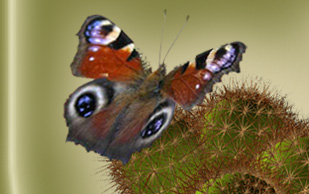Diary of the traveller.
Eugeny Safronov
The Southwest USA
Part 4
We left San Ysidro and turned to north-west. There were many red flowers among the grass at the left side of the road. Only cacti could blossom like that! The reason of our stop was a small river and we moved from the road. It's impossible to leave your car at the roadside in America . It means that something is wrong and a police may appear during 10 minutes. We didn’t need it.
There were marvelous Corynopuntia clavata.
We crossed the deep bed of the river and reached the other bench. And we found Sclerocactus whipplei v.reevesii on the verge of the rapid bench. (RUS304)
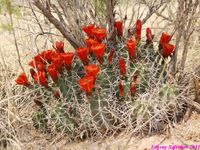
ECHINOCEREUS
gonacanthus
RUS 304 |
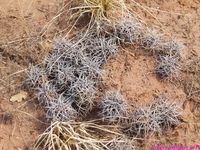
CORYNOPUNTIA
clavata
RUS 304 |
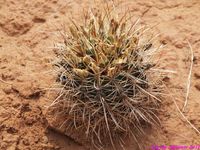
SCLEROCACTUS
whipplei
v.reevesii
RUS 304 |
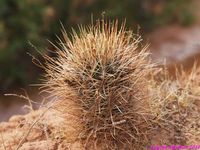
SCLEROCACTUS
whipplei
v.reevesii
RUS 304 |
After tow miles of our way we found Toumeya papyrocantha and Escobaria missouriensis, which are very rare at that place. (RUS 306)
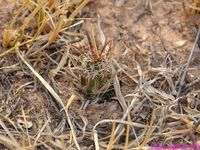
TOUMEYA
papyrocantha
RUS 306 |

TOUMEYA
papyrocantha
RUS 306 |
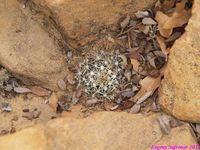
ESCOBARIA
missouriensis
RUS 306 |
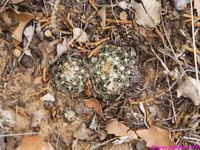
ESCOBARIA
missouriensis
RUS 306 |
Man can't live by cactuses alone! We decided to have a vacation and deviated from our way. We spent the morning at the tourist center Santa Fe . Souvenir shops, cafe and restaurant.
After dinner we visited a very interesting place - Mesa Verde NP .
** Mesa Verde National Park joined a select group of areas designated by UNESCO (United Nations Educational, Scientific and Cultural Organization) as a World Heritage Cultural Site. Mesa Verde National Park was established in 1906, by President Theodore Roosevelt. Mesa Verde National Park offers a spectacular look into the lives of the Ancestral Pueblo people who made it their home for over 700 years, from A.D. 600 to A.D. 1300. Today, the park protects almost 5,000 known archeological sites, including 600 cliff dwellings. These sites are some of the most notable and best preserved in the United States . The park contains over 52,000 acres with 8,500 designated as wilderness. **
We proceeded “our job” at the south from Bloomfield . We were looking for SCLEROCACTUS cloveriae, but found only fine blossoming OPUNTIA engelmannii. There it is SCLEROCACTUS cloveriae! (RUS 307)
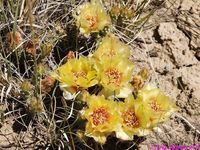
OPUNTIA
engelmannii
RUS 307 |
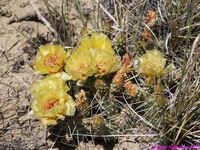
OPUNTIA
engelmannii
RUS 307 |
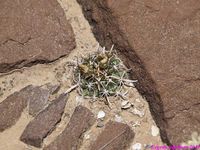
SCLEROCACTUS
cloveriae
RUS 307 |
We are moving to the east near Shiprock. The earth was plane and chapped. And there were only Coloradoa mesae-verdae. The fruits were mellowed; they cracked and showed us their oily inside. (RUS 308)
We went to the barrio near reservation Gospel Church . We left our car in the field rather far from the houses. Then we moved by foot to the point 309, approximately a mile throw the ravines and we didn't want to attract attention. There was Shiprok mountain far off.
SCLEROCACTUS heilii RUS 309
Next day in the morning we left New Mexico . The Utah state welcomed us with flowers, but it was early morning and not all flowers were blossomed. There were mountains with snowy tops ahead. Oh! What a fine view on the mountains!
SCLEROCACTUS whipplei v.roseus, ECHINOCEREUS mojavensis (RUS 310)
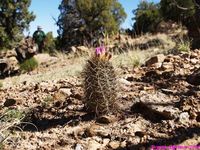
SCLEROCACTUS
whipplei v.roseus
RUS 310 |
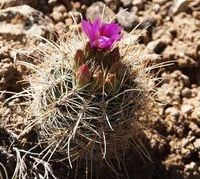
SCLEROCACTUS
whipplei v.roseus
RUS 310 |
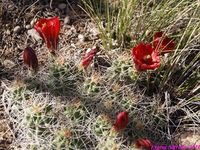
ECHINOCEREUS
mojavensis
RUS 310 |
All the views ahead were much unexpected. There was one thought in my mind – had nature created all that? I had never seen something like that. What unbeknown had created that temple at the valley?
And it was the first! There were the new forms along the road ahead. And then we saw arcs .
We arrived the Park NP Archis. (Between N and M points on the map).
There were many natural monuments in that huge Park, but we had not enough time to visit them all. There are more then 2000 arcs at 309 sq. km. We took an accelerated march by 5 km one way at the 30C to inspect the largest sand arc in the world.
How could all that come into existence? I felt better at the way back when I saw a group of old men, who slowly moved to the arc. We where leaving the Park, but amazing mountain figures were following us.
December 2011.
To be continued...
|
